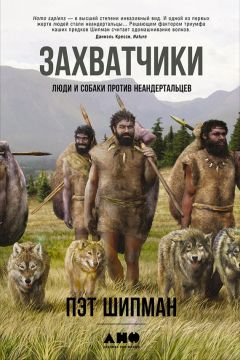189
Germonpré et al., «Fossil Dogs and Wolves,» 482.
N. Ovodov, S. Crockford, Y. Kuzmina et al., «A 33,000-Year-Old Incipient Dog from the Altai Mountains of Siberia: Evidence of the Earliest Domestication Disrupted by the Last Glacial Maximum,» PLoS ONE 6, no. 7 (2011): e22821.
O. Thalmann, B. Shapiro, P. Cui et al., «Complete Mitochondrial Genomes of Ancient Canids Suggest a European Origin of Domestic Dogs,» Science 342 (2013): 871–874.
Ibid., 872.
R. Wayne, personal communication to author, 2012.
J. Avise, On Evolution (Baltimore: Johns Hopkins University Press, 2007), 49–50.
E. Ostrander and R. Wayne, «The Canine Genome,» Genome Research 15 (2005): 1706–1716, doi: 10.1101/gr.3736605.
R. Wayne, «Cranial Morphology of Domestic and Wild Canids: The Influence of Development on Morphological Change,» Evolution 40 (1986): 243–261; R. Wayne, "Limb Morphology of Domestic and Wild Canids: The Influence of Development on Morphologic Chang Journal of Morphology 187 (1986): 301–319.
См. обзор в книге J. Clutton-Brock, Animals as Domesticates: A World View through History (East Lansing: Michigan State University Press, 2012).
R. Coppinger and L. Coppinger, Dogs: A Startling New Understanding of Canine Origin, Behavior, and Evolution (New York: Scribner, 2001).
V. Geist, «When Do Wolves Become Dangerous to Humans?» September 29, 2007, http://www.vargfakta.se/wp-content/uploads/2012/05/Geist-when-do-wolves-become-dangerous-to-humans-pt-l.pdf.
O. Soffer, личная переписка с автором, 15 марта 2013.
L. Marquer, V. Lebretona, T. Otto et al., «Charcoal Scarcity in Epigravettian Settlements with Mammoth Bone Dwellings: The Taphonomic Evidence from Mezhyrich (Ukraine),» Journal of Archaeological Science 39 (2012): 109–120.
См., напр.: S. Leshchinshy and O. Bukharova, «Geochemical Stress of the Krakow-Spadzista Street Mammoth Population Demonstrated by Electron Microscopy,» in The World of Gravettian Hunters, Institute of Systematics and the Evolution of Animals, ed. P. Wojtal (Krakow: Polish Academy of Sciences, 2013), 45–49; S. Leshchinsky, «Lugovskoye: Environment, Taphonomy, and Origin of a Paleofaunal Site,» Archaeology, Ethnology & Anthropology of Eurasia 1, no. 25 (2006): 33–40, doi: 10.1134/S1563011006010026.
N. Bicho, A. Pastoors, and B. Auffermann, eds., Humans Best Friends – Dogs… and Fire! Pleistocene Foragers on the Iberian Peninsula: Their Culture and Environment (Mettmann: Wissenschaftliche Schriften des Neanderthal Museums 7, 2013): 217–242.
V. Ruusila and M. Pesonen, «Interspecific Benefits in Human (Homo sapiens) Hunting: Benefits of a Barking Dog,» Annals of the Zoologica Fennici 41 (2004): 545–549.
J. Koster and K. Tankersley, «Heterogeneity of Hunting Ability and Nutritional Status among Domestic Dogs in Lowland Nicaragua, Hunting Ability,» Proceedings ofthe National Academy of Sciences USA 109 (2012): 463–470, doi: 10.1073/pnas.lll2515109.
K. Lupo, «A Dog Is for Hunting,» in Ethnozooarchaeology, eds. U. Albarella and A. Trentacoste (Oxford: Oxbow Press, 2011), 4–12.
M. Stiner and S. Kuhn, «Paleolithic Diet and the Division of Labor in Mediterranean Eurasia,» in The Evolution of Hominin Diets; Integrating Approaches to the Study of Paleolithic Subsistence, eds. J.-J. Hublin and M. P. Richards (Springer Science and Business Media B. V., 2009): 157–169, p. 161.
C. Arnold, «Possible Evidence of Domestic Dog in a Paleoeskimo Context,» Arctic 32 (1979): 263.
J. Speth, K. Newlander, A. White et al., «Early Paleoindian Big-Game Hunting in North America: Provisioning or Politics?» Quaternary International285 (2013): 121.
C. Turner, «Teeth, Needles, Dogs and Siberia: Bioarchaeological Evidence for the Colonization of the New World,» in The First Americans: The Pleistocene Colonization of the New World, ed. N. Jablonski (San Francisco: California Academy of Sciences, 2002), 123–158.
S. Fiedel, «Man's Best Friend and Mammoth's Worst Enemy? A Speculative Essay on the Role of Dogs in Paleoindian Colonization and Megafaunal Extinction,» World Archaeology 37 (2005): 11–25.
D. Morey and K. Aaris-Sorensen, «Paleoeskimo Dogs of the Eastern Arctic» Arctic 55 (2002): 44–56.
«Hunting a Polar Bear with Dogs,» October 18, 2012, http://retrieverman.net/2012/10/18/hunting-a-polar-bear-with-dogs/; S. Vilhjalmur, The Friendly Arctic: The Story of Five Years in Polar Regions (New York: Macmillan: 1921).
Kuhn and Stiner, «What's a Mother to Do?».
A. Vanak and M. Gompper, «Dogs Canis familiaris as Carnivores: Their Role and Function in Intraguild Competition,» Mammalian Review (2009) 148: 265–283, 281.
Wqjtal et al., «The Scene of Spectacular Feasts,» 135–137.
Данные из работы R. Musil, «Palaeoenvironment at Gravettian Sites Central Europe with Emphasis on Moravia (Czech Republic),» Quartär SI (2010): 95–123.
H. Bocherens, D. Drucker, M. Germonpré et al., «Reconstruction of the Gravettian Food-Web at Predmosti I Using Multi-Isotopic Tracking (13C, 15N, 34S) of Bone Collagen,» Quaternary International, in press.
F. S. Galton, «The First Steps Towards the Domestication of Animals,» Transactions of the Ethnological Society, London (1863) n. s. 1: 122–138; J. Clutton-Brock, A Natural History of Domesticated Animals, 2nd edition (Cambridge: Cambridge University Press, 1999).
A. Sherratt, «The Secondary Exploitation of Animais in the Old World,» World Archaeology, Transhumance and Pastoralism 15, no. 1 (1983): 90–104; A. Sherratt, «Plough and Pastoralism: Aspects of the Secondary Products Revolution,» in Pattern of the Past: Studies in Honour of David Clarke, eds. I. Hodder, G. Isaac, and N. Hammond (Cambridge: Cambridge University Press, 1981): 261–305.
P. Shipman, «And the Last Shall be First,» in Animal Secondary Products: Archaeological Perspectives on Domestic Animal Exploitation in the Neolithic and Bronze Age, ed. H. Greenfield (Oxford: Oxbow Books, 2014), 40–54.
L. Lord, «A Comparison of the Sensory Development of Wolves (Canis lupus lupus) and Dogs (Canis lupus familiaris),» Ethology 119 (2013): 110–120, doi: 10.1111/eth.l2044.
B. Hare and V. Woods, The Genius of Dogs: How Dogs Are than You Think (New York: Dutton, 2013), 76–77.
L. Trut, «Early Canid Domestication: The Farm-Fox Experiment,» American Scientist 87 (1999): 160, doi: 10.1511/1999.2.160; L. Trut, E. Naumenko, and D. Belyaev, «Change in Pituitary-Adrenal Function in Silver Foxes under Selection for Domestication,» Genetika 5 (1972): 35–43 (in Russian, English abstract).
Shipman, The Animal Connection; Shipman, «And the Last.»
J. Bohannon, «Who's (Socially) Smarter: The Dog or the Wolf?» Science Now, May 28, 2013.
P. Smith and C. Litchfield, «How Well Do Dingoes, Canis dingo, Perform on the Detour Task?» Animal Behaviour 80 (2010): 155–162.
Geist, «When Do Wolves Become Dangerous?»
Hare and Woods, Genius of Dogs, 14.
Soffer, Upper Paleolithic of the Central Russian Plain, 258, 187.
Palomares and Caro, «Interspecific Killing.»
Vanak and Gompper, «Dogs Canis familiaris as Carnivores.»
Wojtal et al., «The Scene of Spectacular Feasts.»
G. Haynes, «Utilization and Skeletal Disturbances of North American Prey Carcasses,» Arctic 35 (1982): 266–382.
M. Stiner, «Comparative Ecology and Taphonomy of Spotted Hyenas, Humans, and Wolves in Pleistocene Italy,» Revue de Paléobiologie, Genève 23 (2004): 771–785.
D. Morey, «Burying Key Evidence: The Social Bond between Dogs and People,» Journal of Archaeological Science 33 (2006): 159.
R. Losey, S. Garvie-Lok, J. Leonard et al., «Burying Dogs in Ancient Cis-Baikal, Siberia: Temporal Trends and Relationships with Human Diet and Subsistence Practices,» PLoS ONE 8, no. 5 (2013): 63740–63763; R. Losey, V. Bazaliski, S. Garvie-Lok et al., «Canids as Persons: Early Neolithic Dog and Wolf Burials, Cis-Baikal, Siberia,» Journal of Anthropological Archaeology 30 (2011): 174–189.
K. Maska, «Maska's Diary: The Text of Maska's Diary,» in Early Modern Humans from Predmosti Near Prerova, Czech Republic: A New Reading of Old Documentation, eds. J. Veleminskâ and J. Brüzek (Prague: Academia, 2008), 181–188 (English translation).
Germonpré et al., «Mandibles from Palaeolithic Dogs.»
V. Van Valkenburgh and F. Hertel, «Tough Times at La Brea: Tooth Breakage in Large Carnivores of the Late Pleistocene,» Science 261 (1993): 456–459.
R. Losey, E. Jessup, T. Nomokonova et al., «Craniomandibular Trauma and Tooth Loss in Northern Dogs and Wolves: Implications for the Archaeological Study of Dog Husbandry and Domestication,» PLoS ONE 9, no. 6 (2014): e99746, doi: 10.1371/journal.pone.0099746.
R. White, «Systems of Personal Ornamentation in the Early Upper Palaeolithic: Methodological Challenges and New Observations,» in Rethinking the Human Revolution: New Behavioural and Biological Perspectives on the Origin and Dispersal of Modern Humans, eds. P. Mellars, K. Boyle, O. Bar-Yosef, and C. Stringer (Cambridge: McDonald Institute for Archaeological Research, University of Cambridge, 2007), 299.
P. Bahn, из личного общения с автором, 2011 г.
A. Pike-Тау, из личного общения с автором, 2011 г.
K. Sterelny, The Evolved Apprentice: How Evolution Made Humans Unique (Cambridge, MA: MIT Press, 2012).
D. Morey, «Burying Key Evidence: The Social Bond between Dogs and People,» Journal of Archaeological Science 33 (2006): 167.
Lord, «Comparison of the Sensory Development of Wolves.»
P. Shipman, «Do the Eyes Have It?» American Scientist 100 (2012): 198–201.
H. Kobayashi and S. Kohshima, "Unique Morphology of the Human Eye and Its Adaptive Meaning: Comparative Studies on External Morphology of the Primate «Eye,» Journal of Human Evolution 40 (2001): 419–435.
S. Ueda, G. Kumagi, Y. Otaki et al., «A Comparison of Facial Color Pattern and Gazing Behavior in Canid Species Suggests Gaze Communication in Gray Wolves (Canis lupus),» PLoS ONE 9, no. 6 (2014): 98217–98223, doi: 10.1371/journal.pone.0098217.
M. Tomasello, B. Hare, H. Lehmann et ah, «Reliance on Head Versus Eyes in the Gaze Following of Great Apes and Human Infants: The Cooperative Eye Hypothesis,» Journal of Human Evolution 52 (2007): 314–320.
Anne Pusey, personal communication to author, Jan. 27, 2012.
F. Range and Z. Viranya, «Development of Gaze Following Abilities in Wolves (Canis lupus),» PLoS ONE 6, no. 2 (2012): el6888, doi: 10.1371/journal.pone.0016888.
P. Pongracz, A. Miklosi, K. Timar-Geng et al., «Verbal Attention Getting as a Key Factor in Social Learning between Dog (Canis familiaris) and Human,» Journal of Comparative Psychology 118 (2004): 375–383; B. Hare and M. Tomasello, «Human-Like Social Skills in Dogs?» Trends in Cognitive Sciences 9 (2005): 439–444; B. Hare and M. Tomasello, «Domestic Dogs (Canis familiaris) Use Human and Conspecific Social Cues to Locate Hidden Food,» Journal of Comparative Psychology 113 (1999): 173–177; K. Soproni, A. Miklosi, J. Topal et al., «Dogs' (Canis familiaris) Responsiveness to Human Pointing Gestures,» Journal of Comparative Psychology 116 (2002): 27–34; A. Miklosi, E. Kubinyi, J. Topal et al., «A Simple Reason for a Big Difference: Wolves Do Not Look Back at Humans but Dogs Do,» Current Biology 13 (2003): 763–766.
D. Nogues-Bravo, R. Ohlemuller, R Batra et al., «Climate Predictors of Late Quaternary Extinctions,» Evolution 64 (2010): 2442–2449, doi: 10.1111/j.1558–5646.2010.01009.x.
Dalen et al., «Partial Genetic Turnover in Neanderthals.»
J. Reumer, L. Rook, K. Van Der Borg et al., «Late Pleistocene Survival of the Saber-Toothed Cat Homotherium in Northwestern Europe.» Journal of Vertebrate Paleontology 23 (2003): 260, doi: 10.1671/0272–4634 (2003) 23 [260: LPSOTS]2.0.CO; 2.
L. Rook, из личного общения с автором, 31 июля 2014 г.
A. Stuart and A. Lister, «New Radiocarbon Evidence on the Extirpation of the Spotted Hyaena (Crocuta crocuta (Erxl.)) in Northern Eurasia,» Quaternary Science Reviews 96 (2014): 108–116; H. Bocherens, M. Stiller, K. A. Hobson et al., «Niche Partition between Two Sympatric Genetically Distinct Bears from Austria (Ursus spelaeus and Ursus ingressus),» Quaternary International 245 (2011): 238–248; A. Stuart and A. Lister, «Extinction Chronology of the Cave Lion Panthera spelaea,» Quaternary Science Reviews 30 (2011): 2329–2340; Munzel et al., «Pleistocene Bears»; Stiller et al., «Withering Away»; R. Barnett, B. Shapiro, I. Barnes et al., «Phylogeography of Lions (Panthera leo ssp.) Reveals Three Distinct Taxa and a Late Pleistocene Reduction in Genetic Diversity,» Molecular Ecology 18 (2009): 1668–1677, doi: 10.1111/j.1365-294X. 2009.04134.x; M. Hofreiter, G. Rabedder, V. Jaenicke-Despres et al., «Evidence for Reproductive Isolation between Cave Bear Populations,» Current Biology 14 (2004): 40–43; M. Hofreiter, Ch. Capelli, M. Krings et al., «Ancient DNA Analyses Reveal High Mitochondrial DNA Sequences Diversity and Parallel Morphological Evolution of Late Pleistocene Cave Bears,» Molecular Biology and Evolution 19 (2002): 1244–1250.





